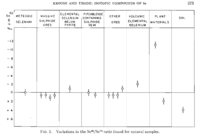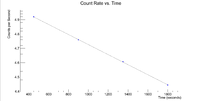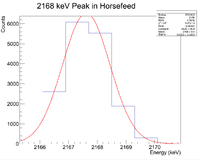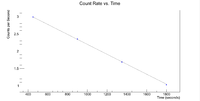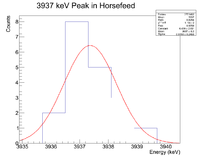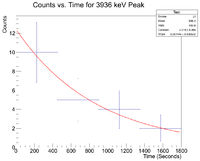PAA Selenium
Using PAA ro measure Selenium concentrations.
According to Krouse<ref name="Krous1962"> H.R. Krause and H.G. Thode,"Thermodynamic Properties and Geochemistry of Iosotopic Compounds of Selenium",.Can. J. Chem., vol 40, pg 367</ref> , the fractional concentration of Se-82/Se-76 in plant material is observed to be less than from primordial (meteoric) concentrations by as much as 1.2%. Anaerobic bacteria are known to reduce selenates and senelites in biological systems. This may be the reason plant material has fractionation of selenium isotopes. They also observe excess concentrations of up to 0.4% in soil.
Plant material appears to detect environmental selenium.
Can one use plant material to measure the provenance of selenium?
As shown in the Figure below, the Se-82/Se-76 ratio varies from -1.2% to +0.2% for plant materials but remains relatively constant for other materials. The variations in plant material has been described as being due to differences in the bacteria residing in the plant. The question to investigate is whether or not these variations in the concentration can be used to determine the provenance of the sample.
Below is a table listing the natural abundances of Selenium
Natural abundance of selenium
| Isotope | Abundance |
| Se-74 | 0.86% |
| Se-76 | 9.23% |
| Se-77 | 7.60% |
| Se-78 | 23.69% |
| Se-80 | 49.80% |
| Se-82 | 8.82% |
Below are possible PAA reactions that may be used to observe specific Se isotopes
| Reaction | Half-life | Relative activity | Gamma-rays, keV (BR) |
| Se-74(gamma,n)Se-73 | 7.1 h | 1.5E-1 | 361 (100) |
| Se-74(gamma,n)Se-73m | 39 m | 3.2 | 402 (4) |
| Se-74(gamma,np)As-72 | 26 h | 1.0E-3 | 834 (100) |
| Se-76(gamma,n)Se-75 | 120 d | 1.3E-2 | 265(29) |
| Se-77(gamma,p)As-76 | 26.4 h | 4.4E-2 | 559(44) |
| Se-78(gamma,p)As-77 | 38.8 h | 8.6E-2 | 239(2) |
| Se-80(gamma,n)Se-79m | 3.9 m | 5.9 | 96(10) |
| Se-80(gamma,np)As-78 | 1.5 h | 2.2E-2 | 614(54) |
| Se-80(gamma,p)As-79 | 8.2 m | 1.3 | 96(9) |
| Se-80(gamma,p)Ge-75 | 83 m | 2.8E-1 | 265(11) |
Can one perform PAA measurements of Se-82 and Se-76?
Experiments
Nickel Normalization
Chlorine
It looks like Cl-35 is abundant as you see photon energies of 146 keV and 2127 keV (you can barely see 1176 keV) from Cl-34's decay (neutron knocked out of Cl-35).
The half life is 32 minutes.
Should check the half life from the run AccOnAlInDetASe-AinDetD_001.root using the calibration
MPA->Draw("0.18063+0.960133*evt.Chan>> SeRun_008(8000,0.5,8000.5)","evt.ADCid==3");
Irradiation of Horse Mineral Supplement
Below is the EMSL report for the horse feed sample. https://wiki.iac.isu.edu/index.php/File:EMSL_Report_Horse_Feed.pdf
Chlorine is a dominant signal
First, look at the peak around 146 keV
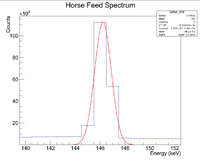
Next I plotted the counts as a function of time to get an exponentially decaying graph. When doing an exponential fit here, the parameter "b" given by root will be the decay constant.
Root gives a half life of 32.9508 +/- 0.01 minutes
Now do the same for the 2127 keV line
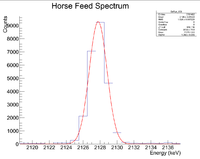
Here are the counts plotted as a function of time
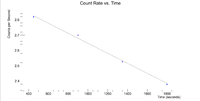
Root gives a half life of 35.3962 +/- 0.2 minutes
Potassium is a potential signal
Looking at the spectrum for the fast irradiation sample, there are 2 prominent lines that could be from 38-K. The mechanism would be a single neutron knockout from a stable 39-K nucleus. The two most dominant energies of the three for 38-K are 2167 keV and 3936 keV and the half life is 7.63 minutes. Below is a fit to the energy spectrum histogram
Now check the half life
Root gives a half life of 8.03 +/- 0.02 minutes
Next check the 3936 peak
and check the half life
Root gives a value for b = - 1.14372x10^(-3), which in turn gives a half life of 10.1 minutes
It seems very possible that 38-K could be in the sample of horse feed.
First Observation of Se lines
Using the 44 Machine at 7 kW power and 44 meV incident electron energy to produce a bremsstrahlung spectrum with a mean energy of 15 meV.
All runs lasting less than 214 seconds have time stamp that gives real time if you divide by clock frequency of 20 MHz. The first 32 bits are used for a real time measurement.
MDA and Se mass Calculations
IAC Detector Efficiencies
Run List
| Date | Time elapsed (Seconds) | Sample | Document Title | Start | Stop | Real | Live | Position |
| 04-01-16 | 2.16x10^6 | Se_B | Se_B_002 | 15:55 | 09:15 | 235989.882 | 235687.660 | k |
| 04-06-16 | 2.592x10^6 | Se_B | Se_B_003 | 12:57 | Interrupted | computer | crash | k |
| 04-14-16 | 3.283x10^6 | Se_B | Se_B_005 | 15:57 | 09:37 | 63581.784 | 63509.895 | k |
| 04-15-16 | 3.37x10^6 | Sample D | Sample_D_001 | 14:47 | 08:23 | 236172.264 | 236173.271 | k |
| 04-19-16 | 3.715x10^6 | Sample B | Sample_B_001 | 15:31 | 15:18 | 85634.862 | 85624.090 | k |
| 4-20-16 | 3.802x10^6 | Sample C | Sample_C_001 | 15:22 | 10:19 | 68253.774 | 68232.238 | k |
| 04-21-16 | 3.888x10^6 | Sample A | Sample_A_001 | 10:22 | 10:37 | 87292.409 | 87268.114 | k |
| 04-25-16 | 4.234x10^6 | Sample E | Sample_E_001 | 11:36 | 10:03 | 80822.406 | 80795.679 | k |
| 04-26-16 | 4.32x10^6 | Se_B | Se_B_008 | 10:06 | 10:29 | 87784.755 | 87664.070 | k |
| 05-05-16 | 5.098x10^6 | Sample A | Sample_A_002 | 13:31 | 14:30 | 3605.507 | 3602.925 | c |
| 05-05-16 | 5.098x10^6 | Sample B | Sample_B_002 | 14:34 | 15:26 | 3114.244 | 3112.620 | c |
| 05-05-16 | 5.098x10^6 | Sample C | Sample_C_002 | 15:28 | 10:57 | 70124.788 | 70044.470 | c |
| 05-06-16 | 5.184x10^6 | Sample D | Sample_D_002 | 10:59 | 15:34 | 16516.898 | 16512.570 | c |
| 05-06-16 | 5.184x10^6 | Sample E | Sample_E_004 | 15:37 | 16:18 | 261654.225 | 261344.308 | c |
| 05-09-16 | 5.443x10^6 | Se B | Se_B_012 | 16:20 | 11:08 | 67157.101 | 66660.298 | c |
| 05-10-16 | 5.5296x10^6 | Sample A | Sample_A_004 | 11:03 | 15:19 | 15379.475 | 15363.017 | c |
| 05-10-16 | 5.5296x10^6 | Sample B | Sample_B_004 | 15:22:04 | 11:43 | 73256.181 | 73220.324 | c |
| 05-16-16 | 6.048x10^6 | Sample C | Sample_C_004 | 16:33 | 08:19 | 56758.980 | 56711.121 | c |
| 05-18-16 | 6.2208x10^6 | Sample D | Sample_D_006 | 08:44:21 | 14:05 | 19271.829 | 19266.929 | c |
| 05-18-16 | 6.2208x10^6 | Sample E | Sample_E_006 | 14:08 | 08:06 | 151108.258 | 150955.915 | c |
| 05-20-16 | 6.3936x10^6 | Se_B | Se_B_014 | 08:08:47 | 08:44 | 261353.204 | 259621.655 | c |
| 05-23-16 | 6.6528x10^6 | Sample A | Sample_A_006 | 08:48 | 13:49 | 18103.004 | 18091.523 | c |
| 05-23-16 | 6.6528x10^6 | Sample B | Sample_B_006 | 13:52 | 13:24 | 84763.938 | 84696.083 | c |
| 05-24-16 | 6.7392x10^6 | Sample C | Sample_C_006 | 13:28:28 | 10:28 | 75571.716 | 75502.871 | c |
| 05-31-16 | 7.344x10^6 | Sample B | Sample_B_008 | 08:57:22 | 08:55 | 86282.861 | 86237.392 | c |
| 06-01-16 | 7.4304x10^6 | Sample C | Sample_C_008 | 08:58:39 | 13:31 | 102739.504 | 102647.471 | c |
| 06-02-16 | 7.5168x10^6 | Sample D | Sample_D_010 | 13:33 | 08:41 | 68915.044 | 68898.246 | c |
SeRun_01-11-16
LB March 2017 Runlist
SeRun_03-07-16
SeRun_02-13-17
LB IAC Radiator Specs
LB Rotating Sample Holder
LB April DetB DetA Calibration
Data Analysis
Pure Se Sample
Observed lines
Estimate of Se-79 activity
Using known efficiency to extrapolate initial activity
Use ratio with Nickel foil rate
Se spiked in Soil
Detection limit of Se in Soil
References
<references/>
File:Krouse CanJournChem 40 1962 p367.pdf
Goryachev, A. M., & Zalesnyy, G. N. (n.d.). The studying of the photoneutron reactions cross sections in the region of the giant dipole resonance in zinc, germanium, selenium, and strontium isotopes. Retrieved September 16, 2016, from http://www-nds.indcentre.org.in/exfor/servlet/X4sSearch5?EntryID=220070
Goryachev, B. I., Ishkhanov, B. S., Kapitonov, I. M., Piskarev, I. M., Piskarev, V. G., & Piskarev, O. P. (n.d.). Giant Dipole Resonance on Ni Isotopes. Retrieved October 26, 2016, from http://www-nds.indcentre.org.in/exfor/servlet/X4sGetSubent?reqx=119235&subID=220597006&plus=1
Handbook on Photonuclear data for applications, cross sections, and spectra. (2000, October). Retrieved November 4, 2016, from http://www-pub.iaea.org/MTCD/Publications/PDF/te_1178_prn.pdf
MSDS
Selenium shot, amorphous, 2-6 mm, Puratronic, 99.999% Alfa Aesar product # 10603 File:AlphaAesarSelenium MDSD.pdf
Informative links
https://inldigitallibrary.inl.gov/sti/3169894.pdf
